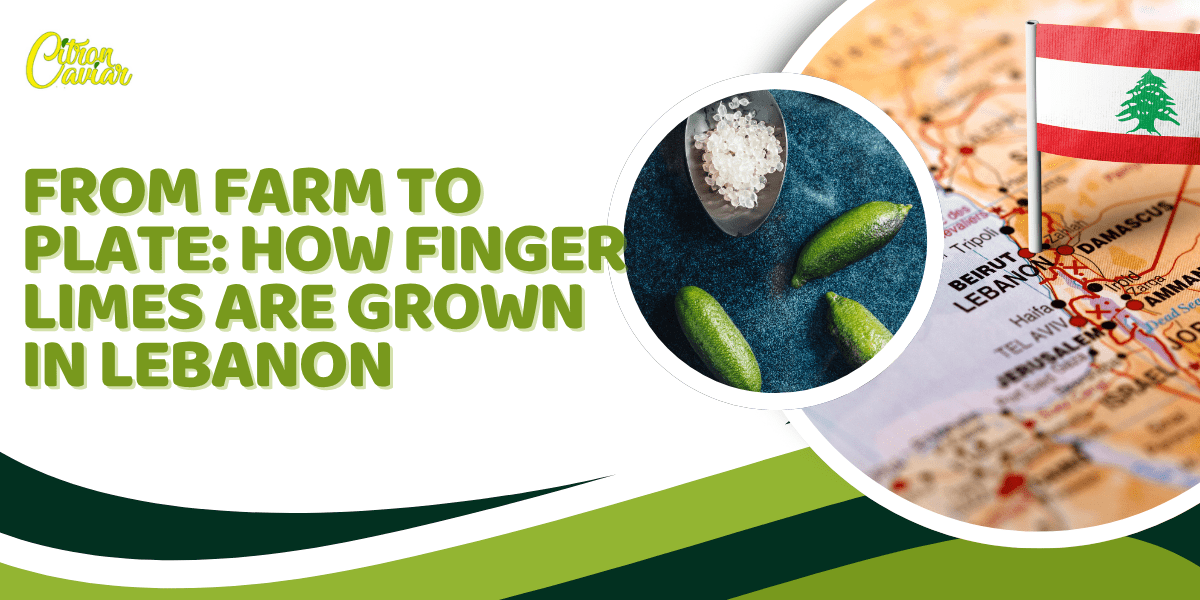From Farm to Plate: How Finger Limes Are Grown in Lebanon

Fine dining is always a luxurious experience around the world. However, there is a new addition to this luxury called Finger limes.
Known as "citrus caviar," finger limes are transforming presentation and plating in gourmet kitchens all over the world. Fine-dining chefs love this uncommon, long-fingered caviar lime fruit because it is packed with tangy, pearl-like vesicles that pop in the mouth.
Finger limes are native to Australia, but farmers who have embraced this niche market are growing them successfully in Lebanon. The nation is making a name for itself in the specialty citrus industry thanks to the ideal climate and meticulous attention to detail.
So, how are finger limes grown in Lebanon, and what challenges do farmers face?
Let’s talk about it.
Why Lebanon? The Perfect Climate for Finger Limes
Lebanese citrus farming already produces oranges, lemons, and other well-known types because of its Mediterranean climate. In this same rich habitat, finger limes have established a niche.
Main benefits of the climate:
- Citrus crops thrive in warm, dry summers and mild winters.
- Foothills and coastal regions (Zones 9–10) are free of frost.
- Finger lime trees require sandy or loamy soils that drain well.
- Availability of water-saving techniques and drip irrigation.
- Using terraced farming techniques aids in erosion and drainage management.
These favourable conditions make it easier to grow finger limes in Lebanon, all the while growing traditional citrus crops.
How Finger Limes Are Grown in Lebanon
Local farmers combine traditional citrus methods with adaptations tailored to the small, prickly finger lime trees.
Among the cultivation techniques are:
- In order to prevent frost, grafted saplings were planted in late spring.
- Trees that are widely separated allow for airflow and harvesting.
- Drip irrigation systems that keep moisture levels steady without becoming soggy.
- Fertilizers with a high potassium content that are specific to citrus and are applied from spring to summer.
- After harvest, prune to get rid of dead branches and keep the shape manageable.
- In colder inland regions, some farms use greenhouses or container cultivation.
In addition to addressing the special characteristics of finger lime plants, these procedures guarantee high yields and high-quality fruit.
Challenges in Finger Lime Farming in Lebanon
Finger lime fruit cultivation is still in its infancy in Lebanon, and farmers encounter a number of particular challenges:
- Restricted availability of rootstock or grafted trees in the area.
- Standard best practices that are adapted to the soil and conditions of Lebanon are lacking.
- Harvesting is labor-intensive due to thorny branches.
- Aphids, mealybugs, and scale are among the pests that need to be regularly observed.
- Diseases like sooty mold and root rot that are brought on by humidity must be managed.
- The region's larger agricultural problems include soil erosion and water scarcity.
- Market risks as a result of the product's novelty and low level of public awareness.
Experts of Finger lime farming in Lebanon see great potential in upscale culinary markets despite these obstacles.
Harvesting and Post-Harvest Handling
You must ask this question: What is the season of Finger Limes?
Most harvests take place in late summer or early fall, and the fruit reaches maturity about 5–7 months after flowering.
The best methods for harvesting and handling:
- Only harvest when the pods are firm and the skin color is vivid.
- To protect the fruit and the picker, use shears and gloves.
- To avoid damaging the vesicles, do not squeeze or stack fruits.
- Wrap finger limes in a moisture-retaining material.
- To increase shelf life by two to three weeks, store at low temperatures (2 to 5°C).
- Without losing their texture, juice pearls can be frozen for extended storage.
These methods enable growers to provide premium fruit to upscale consumers consistently.
From Orchard to Gourmet Plate
Finger limes are swiftly transported from the point of harvest to grocers, restaurants, and specialty distributors throughout Lebanon and beyond. Most purchasers are:
- Luxurious coastal resorts and fine dining establishments in Beirut.
- Cocktail bars are seeking exotic garnishes.
- Food halls and boutique grocers serve intrepid customers.
- Exporters are focusing on specialized markets in the Middle East and Europe.
Lebanese producers are able to command high prices and provide consistent quality to chefs who recognize the value of these distinctive fruits by marketing the product as luxury citrus caviar.
With their vibrant pearls and zesty punch, the finger lime benefits go beyond flavor—offering a premium, nutrient-rich garnish that enhances both taste and presentation.
Conclusion
Finger limes, often referred to as Citron Caviar, are more than just a gourmet garnish—they're a nutrient-rich superfruit packed with antioxidants, vitamin C, and essential oils that support immune health and digestion.
Lebanon’s farmers have harnessed their ideal climate to grow these rare limes with care, overcoming challenges to meet the demands of elite culinary markets. From farm to plate, the journey of green and red finger limes reflects dedication and innovation.
As a leading exporter, Citron Caviar continues to deliver premium-quality finger limes from Lebanon to kitchens around the world, making luxury citrus more accessible than ever.

